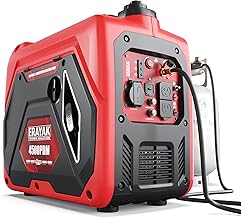What Can a 3500 Watts Generator Run?

A 3500-watt generator is a versatile power source suitable for various applications, from home backup during outages to powering tools on a worksite or appliances during outdoor activities. Understanding what this generator can handle ensures you use it efficiently without overloading.
Understanding Generator Wattage
Generators have two primary wattage ratings:
- Starting (Surge) Watts: The initial burst of power required to start motor-driven appliances.
- Running (Rated) Watts: The continuous power the generator provides to keep appliances running.
For a 3,500-watt generator, typical specifications are around 3,000 running watts and 3,500 starting watts. This means it can continuously supply up to 3,000 watts, with a temporary surge capacity of 3,500 watts for starting appliances.
What Can a 3,500-Watt Generator Run in Your Home?
A 3,500-watt generator can power several essential household appliances, but it’s crucial to manage the load to prevent overloading. Here’s a breakdown of common appliances and their approximate wattage requirements:
| Appliance | Running Watts | Starting Watts |
| Refrigerator/Freezer | 600 | 1,200 |
| Microwave Oven | 1,000 | 1,000 |
| Coffee Maker | 1,000 | 0 |
| Dishwasher | 1,500 | 1,500 |
| Washing Machine | 1,150 | 2,300 |
| Electric Kettle | 1,200 | 0 |
| Space Heater | 1,500 | 0 |
| Sump Pump | 800 | 1,200 |
| Window Air Conditioner | 1,000 | 2,000 |
| Television (LED) | 120 | 0 |
| Laptop Charger | 50 | 0 |
| Lights (per bulb) | 60 | 0 |
Note: Starting watts are additional watts needed for the initial startup of the appliance.
Example Scenario:
If you need to power a refrigerator (600 running watts), a microwave (1,000 watts), and a few lights (let’s say 5 bulbs at 60 watts each = 300 watts), the total running wattage would be:
600 + 1,000 + 300 = 1,900 watts
This setup utilizes 1,900 of the available 3,000 running watts, leaving room for other small devices. However, be mindful of the starting watts, especially if multiple appliances with high starting watts are turned on simultaneously.
Using a 3,500-Watt Generator on a Worksite
For worksites, a 3,500-watt generator can handle various power tools. Here’s a list of common tools and their approximate wattage requirements:
| Power Tool | Running Watts | Starting Watts |
| Circular Saw | 1,400 | 2,300 |
| Drill | 600 | 900 |
| Air Compressor | 1,200 | 2,000 |
| Table Saw | 1,800 | 4,500 |
| Miter Saw | 1,800 | 1,800 |
| Reciprocating Saw | 960 | 960 |
Example Scenario:
Running a circular saw (1,400 running watts) and a drill (600 running watts) simultaneously would require:
1,400 + 600 = 2,000 running watts
This is within the 3,000 running watts limit, allowing for additional tools or equipment, provided their combined usage doesn’t exceed the generator’s capacity.
3,500-Watt Generator for RV and Camping
A 3,500-watt generator is well-suited for RVs and camping, providing enough power for essential appliances. Common RV appliances and their wattage requirements include:
| Appliance | Running Watts | Starting Watts |
| RV Air Conditioner | 1,200 | 2,000 |
| Refrigerator | 600 | 1,200 |
| Microwave Oven | 1,000 | 1,000 |
| Coffee Maker | 600 | 0 |
| Television | 120 | 0 |
| Laptop Charger | 50 | 0 |
Example Scenario:
Powering an RV air conditioner (1,200 running watts) and a refrigerator (600 running watts) simultaneously would require:
1,200 + 600 = 1,800 running watts
This leaves additional capacity for smaller devices like a television or laptop charger.
Important Considerations
- Prioritize Essential Appliances: Determine which appliances are necessary and calculate their total wattage to ensure they don’t exceed the generator’s capacity.
- Starting vs. Running Watts: Be aware of appliances with high starting watts, as they can momentarily surge and potentially overload the generator.
- Fuel Consumption: Running multiple high-wattage appliances will increase fuel consumption. Plan fuel usage accordingly to ensure continuous operation.
- Safety Measures: Always operate generators in well-ventilated areas to prevent carbon monoxide buildup. Use appropriate extension cords and avoid overloading the generator.
A 3500-watt generator is a reliable power source capable of running essential household appliances, power tools, and RV equipment. By understanding the wattage requirements of your devices and managing their usage, you can maximize the efficiency and lifespan of your generator.
